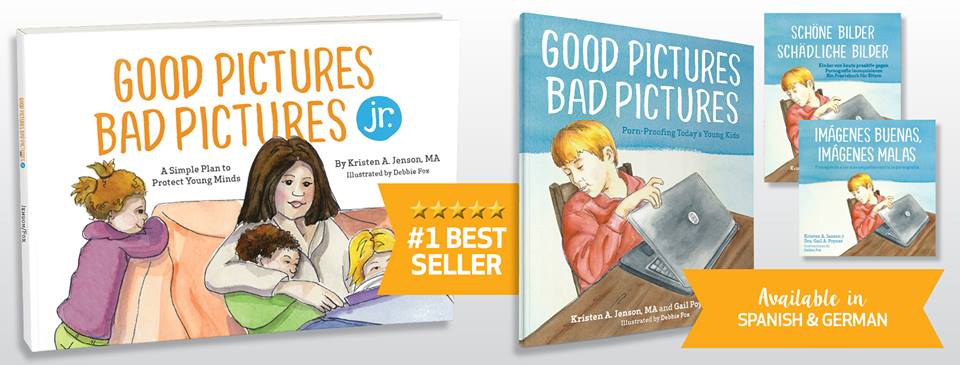By Kristen Jenson, M.A., author of the Good Pictures Bad Pictures book series

In our digitally saturated world, questionable content is always just a click away. So what are we doing to protect kids from porn and its dangerous effects?
Many parents worry that telling their kids about porn might make them more curious to see it.
In reality, it’s better to satisfy their curiosity and answer their questions—proactively, on your own terms.
It’s much safer for them to be curious about pornography with you by their side then for them to be curious when they’re alone on the internet or with a friend.
I join many experts who believe that the days are long gone when parents could avoid the subject of pornography for fear of sparking curiosity. It’s not a matter of IF our children will see porn anymore; it’s a matter of WHEN.
Here are five tips to help parents start talking about pornography:
1) Learn what pediatricians are saying about the impacts of pornography.
Medical doctors are now seeing the physical, mental and emotional effects of viewing pornography–even in children. These include symptoms of anxiety and depression, higher risk for riskier sexual behavior (including assaulting other children), and future problems with marriages. Read more in Pediatricians Speak Out on Impact of Porn.
2) Begin teaching early.
The best age to start talking to a child about pornography is when they first have access to the Internet. If you moved to a new place where there were a lot of scorpions, you would certainly teach your children what the scorpions look like, why they are dangerous, and how to avoid them. It’s the same with internet pornography. There are virtual scorpions hiding inside all our devices.
When you begin teaching, the conversation doesn’t have to be complicated. Even very young children can grasp simple concepts such as: bad pictures exist, they’re called pornography, they can hurt your brain, tell a parent or trusted adult if you ever see something like this.
3) Know how to respond if you discover your child is viewing pornography.
It’s so hard not to freak out, but parents who are prepared are more likely to be able to guide their kids safely away from porn. Namely, parents must deal with their own negative emotions first and then focus on mentoring (not shaming) their kid. So stay calm, focus on how much you love your child, and adopt the role of caretaker and helper as you process the experience together. See the SMART Guide for Parents for more help.
4) Define “pornography.”
A lot of parents don’t want to say this word. I get it! But at a certain point, we have to OWN this word if we intend to have power over it. With very small children it might be sufficient to use the term “bad pictures.” Here’s a simple definition from Good Pictures Bad Pictures Jr.: “Bad pictures show the private parts of the body that we cover with a swimsuit. These parts are meant to be kept private.” See? That wasn’t so hard! For more help with defining pornography, read this.
5) Give kids an “internal filter.”
Many parents feel that their children are safe online as long as a filter is in place. But as we all know, no filter is perfect. Many kids simply see a filter as a challenge–something to get around–like climbing a fence to go play in the woods. Also, what about when they leave the house? What will they see on their friend’s cell phone, at the neighbor’s house, or while they are on public Wi-Fi? There are no guarantees.

How to install an internal filter to protect kids from porn?
I wrote Good Pictures Bad Pictures to give parents comfortable ways to empower their kids with their first internal filter—the only filter that goes with them wherever they go. Here’s what you’ll achieve when you begin talking to your kids about porn and its dangers:
First, you’ll open up the discussion and bring this very dark danger into the light of day.
You’ll let your kids know you want them to come and talk with you and ask you their questions, and you’ll set yourself up as the expert who wants to help them stay safe.
Second, you’ll give your kids a working definition of what pornography is and the vocabulary to talk about it.
They’ll recognize pornography when they see it and have the words to report exposure to you.
Third, you’ll empower kids with a specific PLAN to reject pornography when they see it.
They’ll know exactly what to do! The feedback we’re receiving is that kids get excited about protecting their brains. You can make up your own, or use the plans from Good Pictures Bad Pictures.
In our original book for kids ages 7 to 11, we use the words CAN DO as an acronym for the plan which makes it easy for kids to remember. It teaches kids what they CAN DO to minimize porn’s impact on their thoughts.
Visit our blog to get a FREE poster of the CAN DO plan. Good Pictures Bad Pictures Jr. gives even younger kids (ages 3 -6) a “Turn, Run and Tell” plan. Using either of these plans will empower kids to fight back against accidental exposure to harmful, explicit pornography.
Talking about pornography can seem like a daunting task, but with the right tools in place, parents can tackle this topic and help protect kids from porn. You can be there to answer your children’s questions.
You can set yourself up as the best source of information. You can reduce the shock and shame of inevitable exposure. And that’s the best filter anyone can install.
Every child deserves to have the tools to protect themselves against pornography!

Kristen A. Jenson is the author of the best-selling Good Pictures Bad Pictures series of read-aloud books. She is also founder of ProtectYoungMinds.org, a website dedicated to helping parents empower their kids to reject pornography. Recently, she was invited to testify before the Washington State Senate Law and Justice Committee on the public health crisis of pornography. Kristen is a frequent speaker and guest on podcasts, webinars and radio broadcasts, and is a leader in the Prevention Task Force of the National Coalition to End Sexual Exploitation.
Kristen is the mother of two daughters, and a son who is waiting for her in heaven. She lives with her husband in the beautiful state of Washington. She has a B.A. in English Literature and an M.A. in Organizational Communication.



[…] It means we have to protect kids from porn […]
[…] In this article we will explore the reality of what children and teens will be introduced to online and the ramifications of that exposure in their lives. Next week we will post a follow-up article about how to approach the topic with your children to help them navigate the emotions and habits that could develop from kids viewing pornography. […]
[…] Also, learn how to protect your kids from porn. […]
[…] You CAN get a handle on your triggers and you CAN live a life without pornography! Also, learn how you can protect your kids from porn. […]
[…] We can also help you protect your kids from porn. […]